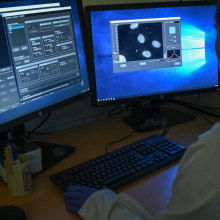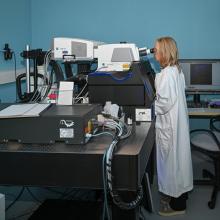Contact
Fabien Milliat

The INTRUST (Innovations Therapeutiques Pour Le Traitement Du Syndrome Gastrointestinal Radio-Induit - Therapeutic Innovations for the Treatment of Radiation-Induced Gastrointestinal Syndrome) project aims to put in place innovative medical countermeasures for the management of radiological exposure resulting in acute intestinal failure.
This 4-year project, launched in 2019, is led by IRSN and also involves the Laboratory for Vascular Translational Science and the Inflammation Research Centre, both of which are INSERM laboratories.
The INTRUST project was selected as part of the ASTRID (Accompagnement Spécifique des travaux de Recherches et d’Innovation Défense - Specific Support for Defence Research and Innovation Work) programme of the ANR (Agence Nationale de la Recherche - National Research Agency and the AID (Agence de l’Innovation de Défense - Agency for Defence Innovation) which aims to support projects of a highly exploratory and innovative nature which can bring both civil and military benefits.
Completion dates : 2020-2023
Funding : 300,000 euros
Partners : IRSN - Laboratory for Vascular Translational Science (INSERM) IRSN - Laboratory for Vascular Translational Science (INSERM) - Inflammation Research Center (INSERM)
Gastrointestinal syndrome (GIS) occurs when the body is exposed to a large volume of ionising radiation greater than 6 Gy. It causes a breakdown of the epithelial barrier in the intestine, which fosters the penetration of pathogens and triggers an intense inflammatory reaction. Management of GIS continues to face a therapeutic brick wall.
Preclinical studies on the implementation of medical measures are all based on monotherapeutic strategies with often disappointing results and there is currently no scientific consensus on a therapeutic solution for the management of GIS.
The radiation-induced intestinal lesions of GIS are very similar to those seen in patients with chronic inflammatory bowel diseases (IBD), such as Crohn's disease or ulcerative colitis. In fact, they share identical symptoms (abdominal pain, frequent diarrhoea, bleeding) associated with inflammation of the digestive tract and destruction of the intestinal epithelium. The contemporary clinical view of IBD is moving towards multimodal strategies that could be applied to GIS, due to the pathophysiological characteristics common to both these diseases.
This is why the INTRUST project proposes a strategy based on the assumption that only comprehensive and multimodal treatment could really be effective, reliable and accessible to a large number of victims for the treatment of GIS.
The project aims to demonstrate the benefit and feasibility of a therapeutic approach by highlighting 3 key elements required for an effective therapeutic strategy: acting quickly after irradiation to physically protect the intestinal mucosa, combining therapeutic agents that regenerate the digestive mucosa and managing intestinal inflammation with immunomodulators.
Therefore, the INTRUST project seeks to:
The project's scientific programme is broken down into 4 work packages (WP) :
WP1 aims to develop a mucoadhesive biogel (MABG) compatible with regenerative medicine and a biomaterial used for the in vitro creation of human intestinal organoids.
In order to avoid septic shock, it is essential to maintain the physical barrier that protects the body from gut bacteria. This barrier is normally formed by a layer of mucus rich in glycoproteins which form a network of polymers. The INTRUST project aims to develop a MABG that mimics the properties of this mucus layer. In the case of GIS, the biogel should be quickly applied to the entire intestine. This is why WP1 is also responsible for studying the most effective routes of administration. The envisaged solutions are direct application by endoscopy or orally using a capsule containing the components that will allow the biogel to be created in the intestine by means of a gradual coating.
In parallel, WP1 must prepare the biomaterial which acts as a matrix for the culture of organoids. This matrix must provide the cells with an environment similar to that of the extracellular matrix of the original organ in order to allow proliferation and differentiation of the cells. However, Matrigel, a hydrogel derived from extracellular matrix secreted by cancer cells in animals and traditionally used in the culture of organoids, can interfere with experiments carried out on organoids because of its tumoral character. The biomaterial developed by WP1 aims to overcome this shortfall.
This research axis is devoted to a study of the effects of epithelial regeneration molecules and cell therapy products on organoids that have been previously irradiated in order to reproduce the conditions of a GIS.
The project aims to promote the plasticity of cells in the intestinal epithelium and to stimulate the differentiation of stem cells present in the intestinal crypts involved in the natural renewal of intestinal cells.
The work carried out within the framework of WP3 is aimed at validating the efficacy of the biomaterial selected within the framework of WP1 for the design of mucoadhesive biogels based on the mouse as an animal model.
This research axis should also assess the possibility of managing intestinal inflammation by incorporating immunomodulators into MABG. Pairing an anti-inflammatory with the gel would make it possible to obtain an optimised integrity of the barrier by means of the physical protection of the biogel and the anti-inflammatory effect which would make it possible to "close" tight epithelial junctions and reduce bacterial translocation and resulting inflammation. This pairing would also make it possible to minimise the diffusion of antibodies in the stool and to maximise their lifespan and their local action.
Finally, WP3 will assess the effectiveness and adhesive properties of the biogel according to the different administration methods provided for by WP1.
The last axis of the INTRUST project is responsible for validating the effectiveness of the combination of treatments put in place in work packages 1 to 3 on pre-clinical models of radiation-induced (GIS) or chronic inflammatory (IBD) gastrointestinal lesions.
Initially, it will be a question of validating, on a model of radio-induced gastrointestinal lesions, the therapeutic efficacy of the mucosa regenerating molecules identified in WP2 in association with the MABG from WP3. Secondly, WP4 will integrate the immunomodulators and will evaluate the therapeutic benefits of this multimodal treatment.
Validation of this treatment will be based on intestinal permeability by means of fluorescent molecules, on the regenerative capacity of the mucosa by counting intestinal crypts and on the proliferation of stem cells, identified by immunostaining.
Laboratories : LRMed - Medical exposure radiobiology laboratory

The aim of LRMed is to acquire new knowledge on the biological mechanisms of initiation and progression of localized lesions in healthy tissues resulting from exposure to ionizing radiation, at moderate and high doses, used in the medical field for diagnostic or therapeutic purposes (e.g. radiotherapy) to better predict the risks of complications, better understand, prevent and treat them.
Fabien Milliat